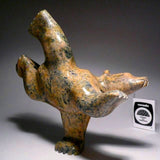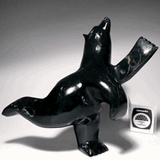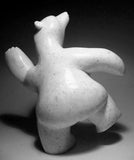Cape Dorset (Kinngait)
 Over 1,200 people reside in the Inuit community of Cape Dorset. It is located on the south west coast of Baffin Island on the Foxe Peninsula.
Over 1,200 people reside in the Inuit community of Cape Dorset. It is located on the south west coast of Baffin Island on the Foxe Peninsula.
Cape Dorset, is the "capital for Inuit art". They are the largest producer in the world for Inuit carvings. Inuit art is Cape Dorset's main industry and it produces both Inuit carvings and Inuit prints.
 One of the reasons why Cape Dorset is world renowned for its art, is simply because it was the first community to innovate and properly market the legend of the Dancing Bear. The Dancing bear exemplifies and attests the true beauty and skill of Inuit art. They are by far the most in demand subjects by consumers today. The dancing bear is inspired by the concept of transformation between shaman and spirit helper or spirit animal; arctic animals adopting naturalistic or humorous human-like poses (e.g. dancing bears, and Sedna - the sea goddess),
One of the reasons why Cape Dorset is world renowned for its art, is simply because it was the first community to innovate and properly market the legend of the Dancing Bear. The Dancing bear exemplifies and attests the true beauty and skill of Inuit art. They are by far the most in demand subjects by consumers today. The dancing bear is inspired by the concept of transformation between shaman and spirit helper or spirit animal; arctic animals adopting naturalistic or humorous human-like poses (e.g. dancing bears, and Sedna - the sea goddess),


 As the Dancing Bear is by far the most in demand subject in Inuit art today, there are other factors that are responsible to its wide mass appeal. One of these factors is the detail and skill involved that is needed in order for the bear to balance on one foot. This is a very difficult task for the artist to do. A well done dancing bear should be capable of balancing on one foot alone without the addition of any support (like a base plate underneath). A well done dancing bear should never be standing on anything. It should balance perfectly on one leg. Some artists like Johnny Manning are so skilled that they are able to carve a bear that can stand on either leg and in some cases, do a hand stand. People also admire dancing bears because of their positive and happy aura which surrounds them. This of course is another reason why they are so admired. They are beautiful figures as there is much movement and grace. In conclusion, Cape Dorset were the innovators of the dancing bear and is where most of them are carved today.
As the Dancing Bear is by far the most in demand subject in Inuit art today, there are other factors that are responsible to its wide mass appeal. One of these factors is the detail and skill involved that is needed in order for the bear to balance on one foot. This is a very difficult task for the artist to do. A well done dancing bear should be capable of balancing on one foot alone without the addition of any support (like a base plate underneath). A well done dancing bear should never be standing on anything. It should balance perfectly on one leg. Some artists like Johnny Manning are so skilled that they are able to carve a bear that can stand on either leg and in some cases, do a hand stand. People also admire dancing bears because of their positive and happy aura which surrounds them. This of course is another reason why they are so admired. They are beautiful figures as there is much movement and grace. In conclusion, Cape Dorset were the innovators of the dancing bear and is where most of them are carved today.

 Cape Dorset artists are known for making large-scale stone sculptures. One of the best Inuit artists in the world for dancing bears is master carver Nuna Parr. Nuna Parr is the most famous Inuit artist in the world. Because he is so in-demand, his dancing bears sell in auctions for very high prices.
Cape Dorset artists are known for making large-scale stone sculptures. One of the best Inuit artists in the world for dancing bears is master carver Nuna Parr. Nuna Parr is the most famous Inuit artist in the world. Because he is so in-demand, his dancing bears sell in auctions for very high prices.  He only likes to carve large dancing bears which are notably famous for their immense sizes and having much movement and grace. A Nuna Parr bear is unmistakable and is in extreme high demand by collectors.
He only likes to carve large dancing bears which are notably famous for their immense sizes and having much movement and grace. A Nuna Parr bear is unmistakable and is in extreme high demand by collectors.
 Contrary to Lew Phillip, Toonoo Sharky (who is also mentioned in the same breath as master carvers). centers his pieces to cater to a more modernistic and exaggerated style. There are no limits to what Toonoo will carve, however a common theme each piece will have (owl, fish, bird) are its piercing big eyes. His carvings appeal to a more modernistic and contemporary audience. Other strong artists that are well known from Cape Dorset are Noo Atsiaq (dancing bears), Pudlalik Shaa (dancing goose), and Johnny Raggae (large dancing bears).
Contrary to Lew Phillip, Toonoo Sharky (who is also mentioned in the same breath as master carvers). centers his pieces to cater to a more modernistic and exaggerated style. There are no limits to what Toonoo will carve, however a common theme each piece will have (owl, fish, bird) are its piercing big eyes. His carvings appeal to a more modernistic and contemporary audience. Other strong artists that are well known from Cape Dorset are Noo Atsiaq (dancing bears), Pudlalik Shaa (dancing goose), and Johnny Raggae (large dancing bears).
 Inuit prints are also a huge market for Inuit art and has a very strong presence in Cape Dorset as well. Kenojuak Ashevak and Kananginak Pootoogook. Inuit prints are in very high demand. There are usually two collections that come out every year. One in the fall and one in the spring. The fall collection is the larger one.
Inuit prints are also a huge market for Inuit art and has a very strong presence in Cape Dorset as well. Kenojuak Ashevak and Kananginak Pootoogook. Inuit prints are in very high demand. There are usually two collections that come out every year. One in the fall and one in the spring. The fall collection is the larger one.
